Financial Resource Management Task 1: Assessment One Solution
VerifiedAdded on 2023/01/11
|15
|5339
|52
Homework Assignment
AI Summary
This assignment solution delves into the core principles of financial resource management, encompassing the revenue, expense, matching, cost, and objectivity principles. It then provides a detailed analysis of financial statements, including profit and loss statements, balance sheets, and cash flow statements, explaining their key features and interrelationships. The solution also explores different types of communication, such as written and oral, and their application in a business context. Additionally, it covers essential aspects of effective communication in the workplace, emphasizing data-driven and collaborative approaches. Finally, the document outlines the requirements for financial reporting, including the necessary documents and the GST reporting cycle, providing a comprehensive overview of financial management concepts.
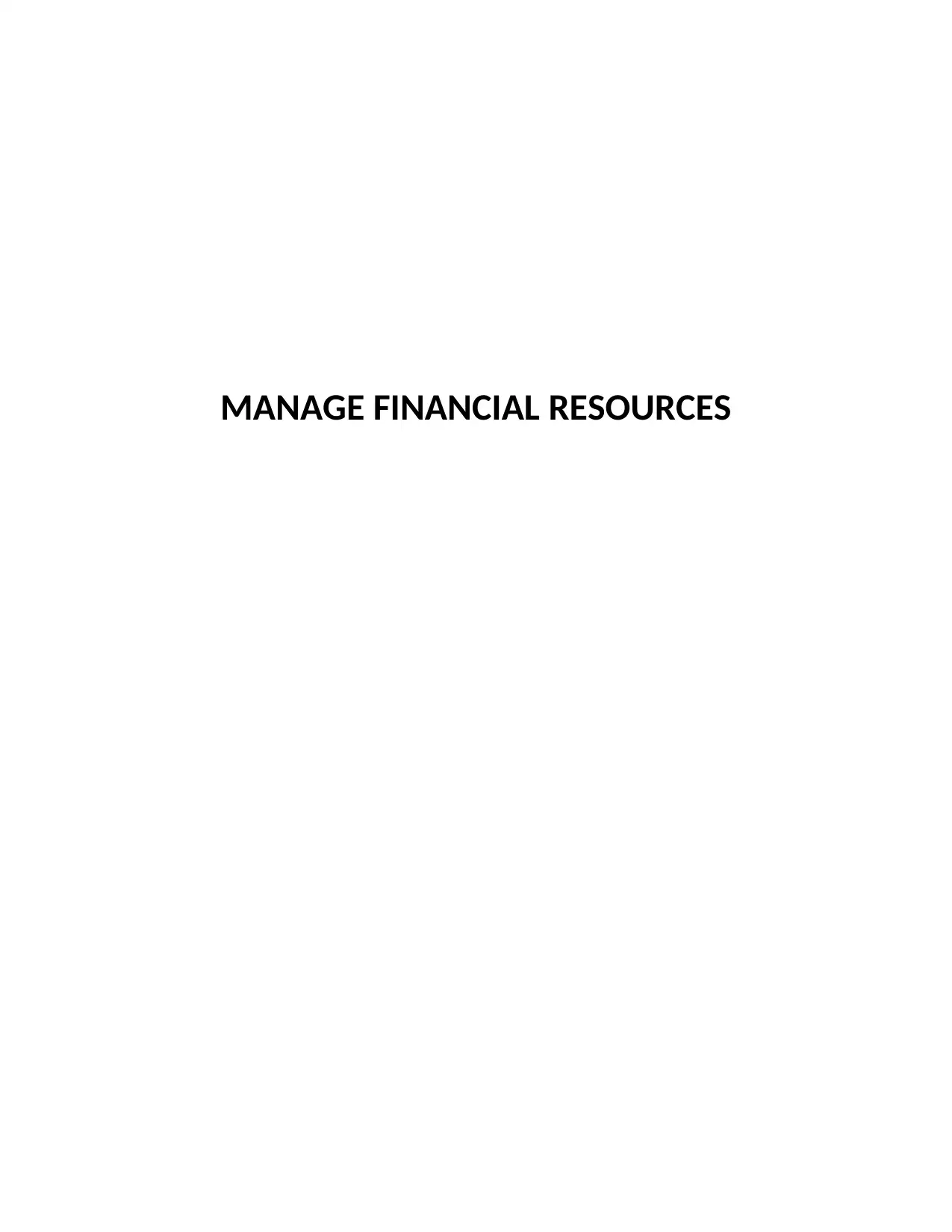
MANAGE FINANCIAL RESOURCES
Paraphrase This Document
Need a fresh take? Get an instant paraphrase of this document with our AI Paraphraser
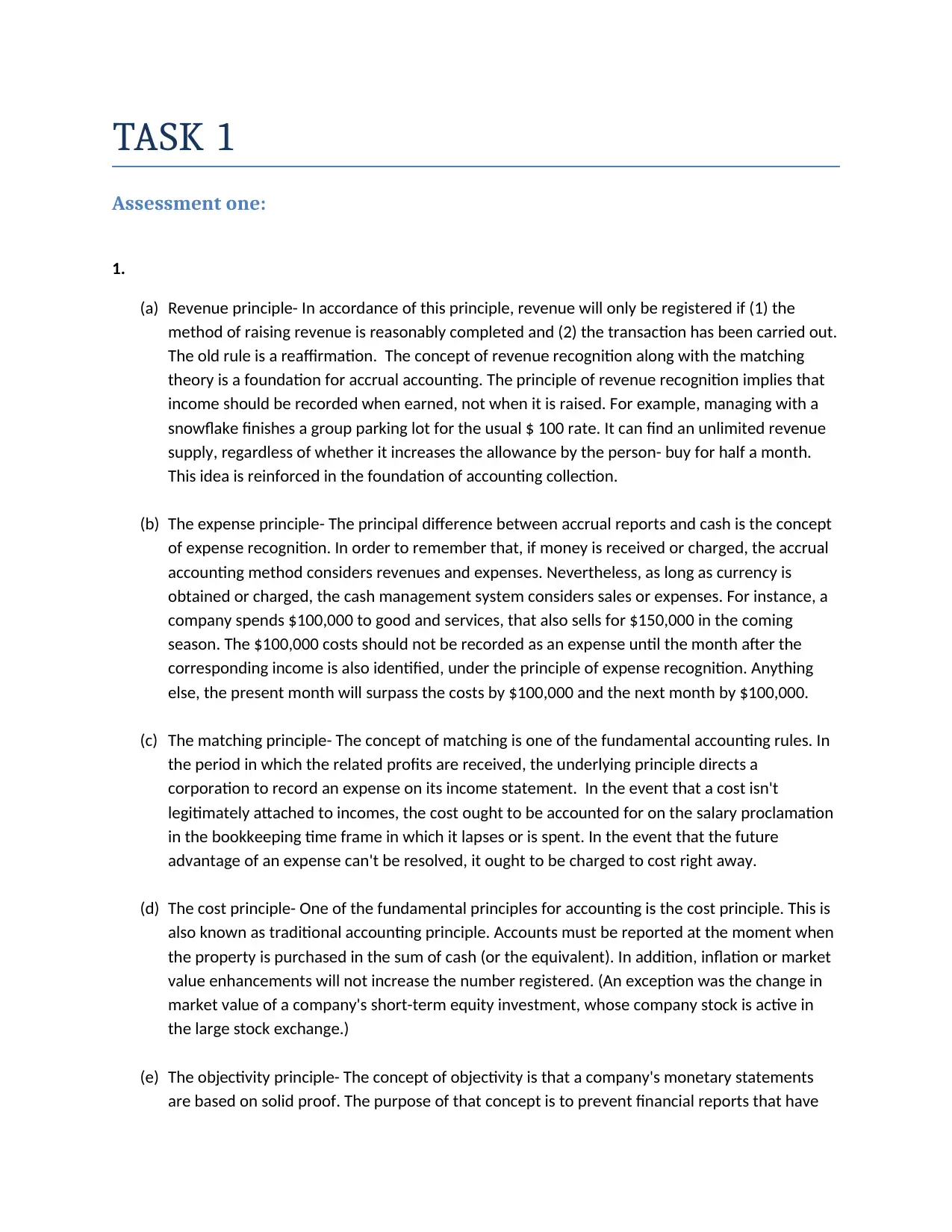
TASK 1
Assessment one:
1.
(a) Revenue principle- In accordance of this principle, revenue will only be registered if (1) the
method of raising revenue is reasonably completed and (2) the transaction has been carried out.
The old rule is a reaffirmation. The concept of revenue recognition along with the matching
theory is a foundation for accrual accounting. The principle of revenue recognition implies that
income should be recorded when earned, not when it is raised. For example, managing with a
snowflake finishes a group parking lot for the usual $ 100 rate. It can find an unlimited revenue
supply, regardless of whether it increases the allowance by the person- buy for half a month.
This idea is reinforced in the foundation of accounting collection.
(b) The expense principle- The principal difference between accrual reports and cash is the concept
of expense recognition. In order to remember that, if money is received or charged, the accrual
accounting method considers revenues and expenses. Nevertheless, as long as currency is
obtained or charged, the cash management system considers sales or expenses. For instance, a
company spends $100,000 to good and services, that also sells for $150,000 in the coming
season. The $100,000 costs should not be recorded as an expense until the month after the
corresponding income is also identified, under the principle of expense recognition. Anything
else, the present month will surpass the costs by $100,000 and the next month by $100,000.
(c) The matching principle- The concept of matching is one of the fundamental accounting rules. In
the period in which the related profits are received, the underlying principle directs a
corporation to record an expense on its income statement. In the event that a cost isn't
legitimately attached to incomes, the cost ought to be accounted for on the salary proclamation
in the bookkeeping time frame in which it lapses or is spent. In the event that the future
advantage of an expense can't be resolved, it ought to be charged to cost right away.
(d) The cost principle- One of the fundamental principles for accounting is the cost principle. This is
also known as traditional accounting principle. Accounts must be reported at the moment when
the property is purchased in the sum of cash (or the equivalent). In addition, inflation or market
value enhancements will not increase the number registered. (An exception was the change in
market value of a company's short-term equity investment, whose company stock is active in
the large stock exchange.)
(e) The objectivity principle- The concept of objectivity is that a company's monetary statements
are based on solid proof. The purpose of that concept is to prevent financial reports that have
Assessment one:
1.
(a) Revenue principle- In accordance of this principle, revenue will only be registered if (1) the
method of raising revenue is reasonably completed and (2) the transaction has been carried out.
The old rule is a reaffirmation. The concept of revenue recognition along with the matching
theory is a foundation for accrual accounting. The principle of revenue recognition implies that
income should be recorded when earned, not when it is raised. For example, managing with a
snowflake finishes a group parking lot for the usual $ 100 rate. It can find an unlimited revenue
supply, regardless of whether it increases the allowance by the person- buy for half a month.
This idea is reinforced in the foundation of accounting collection.
(b) The expense principle- The principal difference between accrual reports and cash is the concept
of expense recognition. In order to remember that, if money is received or charged, the accrual
accounting method considers revenues and expenses. Nevertheless, as long as currency is
obtained or charged, the cash management system considers sales or expenses. For instance, a
company spends $100,000 to good and services, that also sells for $150,000 in the coming
season. The $100,000 costs should not be recorded as an expense until the month after the
corresponding income is also identified, under the principle of expense recognition. Anything
else, the present month will surpass the costs by $100,000 and the next month by $100,000.
(c) The matching principle- The concept of matching is one of the fundamental accounting rules. In
the period in which the related profits are received, the underlying principle directs a
corporation to record an expense on its income statement. In the event that a cost isn't
legitimately attached to incomes, the cost ought to be accounted for on the salary proclamation
in the bookkeeping time frame in which it lapses or is spent. In the event that the future
advantage of an expense can't be resolved, it ought to be charged to cost right away.
(d) The cost principle- One of the fundamental principles for accounting is the cost principle. This is
also known as traditional accounting principle. Accounts must be reported at the moment when
the property is purchased in the sum of cash (or the equivalent). In addition, inflation or market
value enhancements will not increase the number registered. (An exception was the change in
market value of a company's short-term equity investment, whose company stock is active in
the large stock exchange.)
(e) The objectivity principle- The concept of objectivity is that a company's monetary statements
are based on solid proof. The purpose of that concept is to prevent financial reports that have
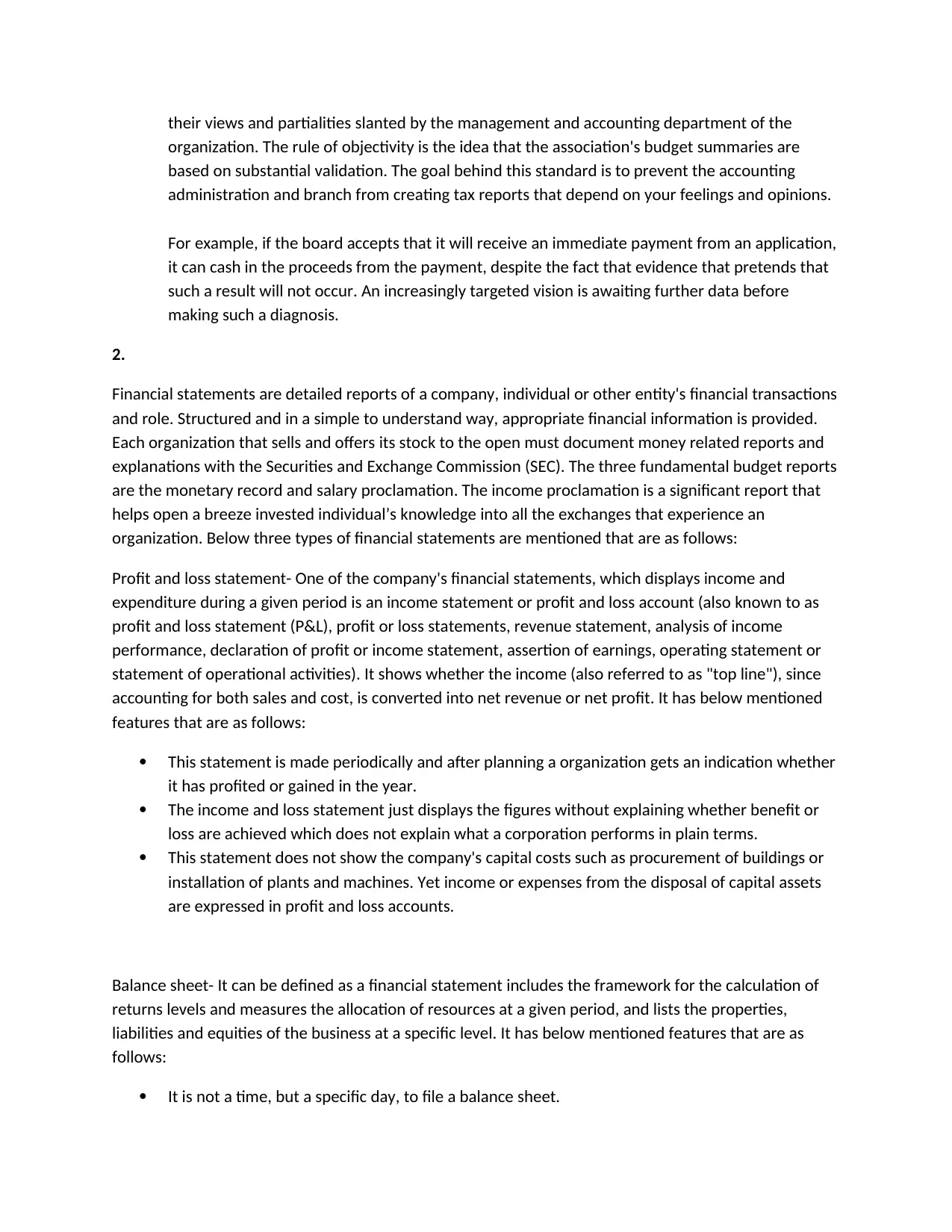
their views and partialities slanted by the management and accounting department of the
organization. The rule of objectivity is the idea that the association's budget summaries are
based on substantial validation. The goal behind this standard is to prevent the accounting
administration and branch from creating tax reports that depend on your feelings and opinions.
For example, if the board accepts that it will receive an immediate payment from an application,
it can cash in the proceeds from the payment, despite the fact that evidence that pretends that
such a result will not occur. An increasingly targeted vision is awaiting further data before
making such a diagnosis.
2.
Financial statements are detailed reports of a company, individual or other entity's financial transactions
and role. Structured and in a simple to understand way, appropriate financial information is provided.
Each organization that sells and offers its stock to the open must document money related reports and
explanations with the Securities and Exchange Commission (SEC). The three fundamental budget reports
are the monetary record and salary proclamation. The income proclamation is a significant report that
helps open a breeze invested individual’s knowledge into all the exchanges that experience an
organization. Below three types of financial statements are mentioned that are as follows:
Profit and loss statement- One of the company's financial statements, which displays income and
expenditure during a given period is an income statement or profit and loss account (also known to as
profit and loss statement (P&L), profit or loss statements, revenue statement, analysis of income
performance, declaration of profit or income statement, assertion of earnings, operating statement or
statement of operational activities). It shows whether the income (also referred to as "top line"), since
accounting for both sales and cost, is converted into net revenue or net profit. It has below mentioned
features that are as follows:
This statement is made periodically and after planning a organization gets an indication whether
it has profited or gained in the year.
The income and loss statement just displays the figures without explaining whether benefit or
loss are achieved which does not explain what a corporation performs in plain terms.
This statement does not show the company's capital costs such as procurement of buildings or
installation of plants and machines. Yet income or expenses from the disposal of capital assets
are expressed in profit and loss accounts.
Balance sheet- It can be defined as a financial statement includes the framework for the calculation of
returns levels and measures the allocation of resources at a given period, and lists the properties,
liabilities and equities of the business at a specific level. It has below mentioned features that are as
follows:
It is not a time, but a specific day, to file a balance sheet.
organization. The rule of objectivity is the idea that the association's budget summaries are
based on substantial validation. The goal behind this standard is to prevent the accounting
administration and branch from creating tax reports that depend on your feelings and opinions.
For example, if the board accepts that it will receive an immediate payment from an application,
it can cash in the proceeds from the payment, despite the fact that evidence that pretends that
such a result will not occur. An increasingly targeted vision is awaiting further data before
making such a diagnosis.
2.
Financial statements are detailed reports of a company, individual or other entity's financial transactions
and role. Structured and in a simple to understand way, appropriate financial information is provided.
Each organization that sells and offers its stock to the open must document money related reports and
explanations with the Securities and Exchange Commission (SEC). The three fundamental budget reports
are the monetary record and salary proclamation. The income proclamation is a significant report that
helps open a breeze invested individual’s knowledge into all the exchanges that experience an
organization. Below three types of financial statements are mentioned that are as follows:
Profit and loss statement- One of the company's financial statements, which displays income and
expenditure during a given period is an income statement or profit and loss account (also known to as
profit and loss statement (P&L), profit or loss statements, revenue statement, analysis of income
performance, declaration of profit or income statement, assertion of earnings, operating statement or
statement of operational activities). It shows whether the income (also referred to as "top line"), since
accounting for both sales and cost, is converted into net revenue or net profit. It has below mentioned
features that are as follows:
This statement is made periodically and after planning a organization gets an indication whether
it has profited or gained in the year.
The income and loss statement just displays the figures without explaining whether benefit or
loss are achieved which does not explain what a corporation performs in plain terms.
This statement does not show the company's capital costs such as procurement of buildings or
installation of plants and machines. Yet income or expenses from the disposal of capital assets
are expressed in profit and loss accounts.
Balance sheet- It can be defined as a financial statement includes the framework for the calculation of
returns levels and measures the allocation of resources at a given period, and lists the properties,
liabilities and equities of the business at a specific level. It has below mentioned features that are as
follows:
It is not a time, but a specific day, to file a balance sheet.
⊘ This is a preview!⊘
Do you want full access?
Subscribe today to unlock all pages.

Trusted by 1+ million students worldwide
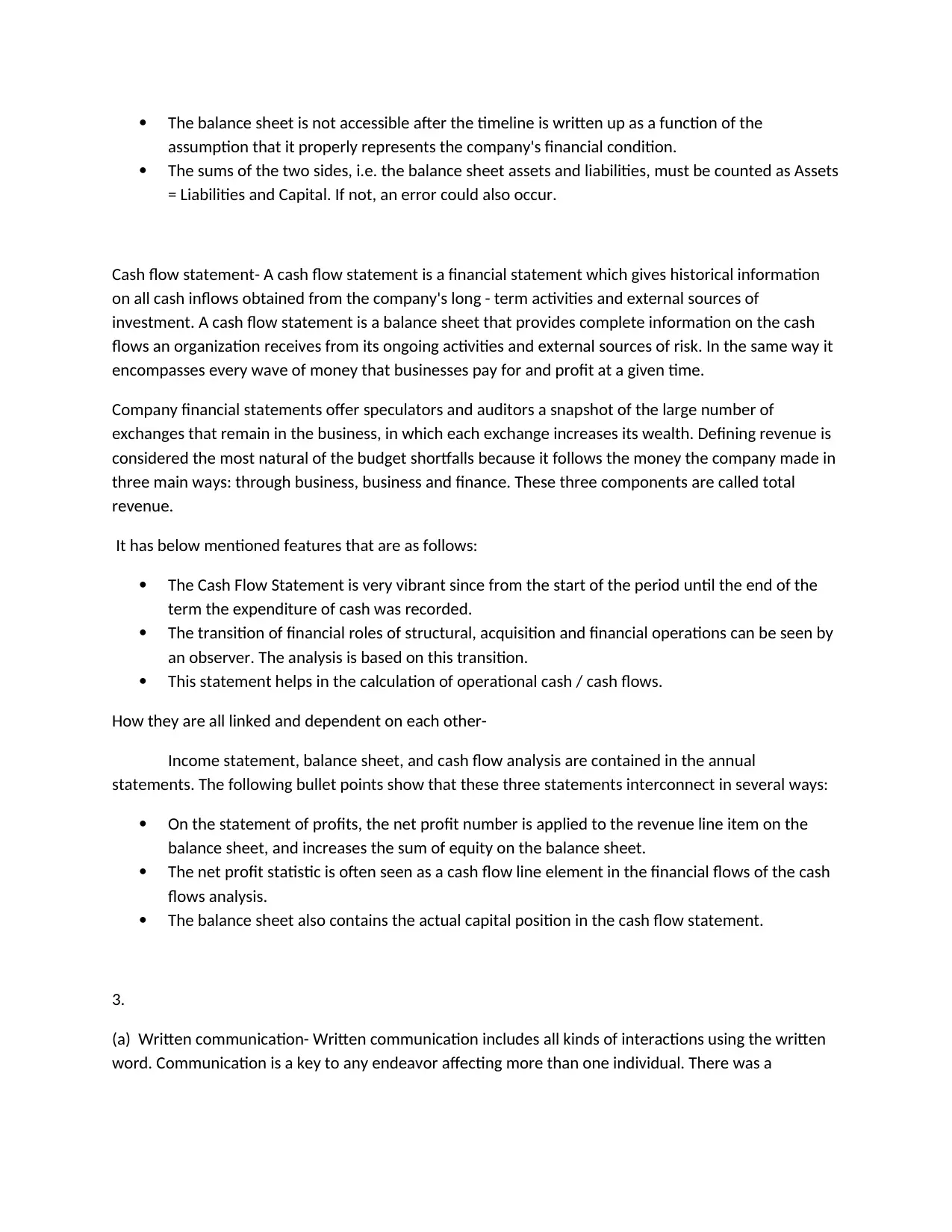
The balance sheet is not accessible after the timeline is written up as a function of the
assumption that it properly represents the company's financial condition.
The sums of the two sides, i.e. the balance sheet assets and liabilities, must be counted as Assets
= Liabilities and Capital. If not, an error could also occur.
Cash flow statement- A cash flow statement is a financial statement which gives historical information
on all cash inflows obtained from the company's long - term activities and external sources of
investment. A cash flow statement is a balance sheet that provides complete information on the cash
flows an organization receives from its ongoing activities and external sources of risk. In the same way it
encompasses every wave of money that businesses pay for and profit at a given time.
Company financial statements offer speculators and auditors a snapshot of the large number of
exchanges that remain in the business, in which each exchange increases its wealth. Defining revenue is
considered the most natural of the budget shortfalls because it follows the money the company made in
three main ways: through business, business and finance. These three components are called total
revenue.
It has below mentioned features that are as follows:
The Cash Flow Statement is very vibrant since from the start of the period until the end of the
term the expenditure of cash was recorded.
The transition of financial roles of structural, acquisition and financial operations can be seen by
an observer. The analysis is based on this transition.
This statement helps in the calculation of operational cash / cash flows.
How they are all linked and dependent on each other-
Income statement, balance sheet, and cash flow analysis are contained in the annual
statements. The following bullet points show that these three statements interconnect in several ways:
On the statement of profits, the net profit number is applied to the revenue line item on the
balance sheet, and increases the sum of equity on the balance sheet.
The net profit statistic is often seen as a cash flow line element in the financial flows of the cash
flows analysis.
The balance sheet also contains the actual capital position in the cash flow statement.
3.
(a) Written communication- Written communication includes all kinds of interactions using the written
word. Communication is a key to any endeavor affecting more than one individual. There was a
assumption that it properly represents the company's financial condition.
The sums of the two sides, i.e. the balance sheet assets and liabilities, must be counted as Assets
= Liabilities and Capital. If not, an error could also occur.
Cash flow statement- A cash flow statement is a financial statement which gives historical information
on all cash inflows obtained from the company's long - term activities and external sources of
investment. A cash flow statement is a balance sheet that provides complete information on the cash
flows an organization receives from its ongoing activities and external sources of risk. In the same way it
encompasses every wave of money that businesses pay for and profit at a given time.
Company financial statements offer speculators and auditors a snapshot of the large number of
exchanges that remain in the business, in which each exchange increases its wealth. Defining revenue is
considered the most natural of the budget shortfalls because it follows the money the company made in
three main ways: through business, business and finance. These three components are called total
revenue.
It has below mentioned features that are as follows:
The Cash Flow Statement is very vibrant since from the start of the period until the end of the
term the expenditure of cash was recorded.
The transition of financial roles of structural, acquisition and financial operations can be seen by
an observer. The analysis is based on this transition.
This statement helps in the calculation of operational cash / cash flows.
How they are all linked and dependent on each other-
Income statement, balance sheet, and cash flow analysis are contained in the annual
statements. The following bullet points show that these three statements interconnect in several ways:
On the statement of profits, the net profit number is applied to the revenue line item on the
balance sheet, and increases the sum of equity on the balance sheet.
The net profit statistic is often seen as a cash flow line element in the financial flows of the cash
flows analysis.
The balance sheet also contains the actual capital position in the cash flow statement.
3.
(a) Written communication- Written communication includes all kinds of interactions using the written
word. Communication is a key to any endeavor affecting more than one individual. There was a
Paraphrase This Document
Need a fresh take? Get an instant paraphrase of this document with our AI Paraphraser
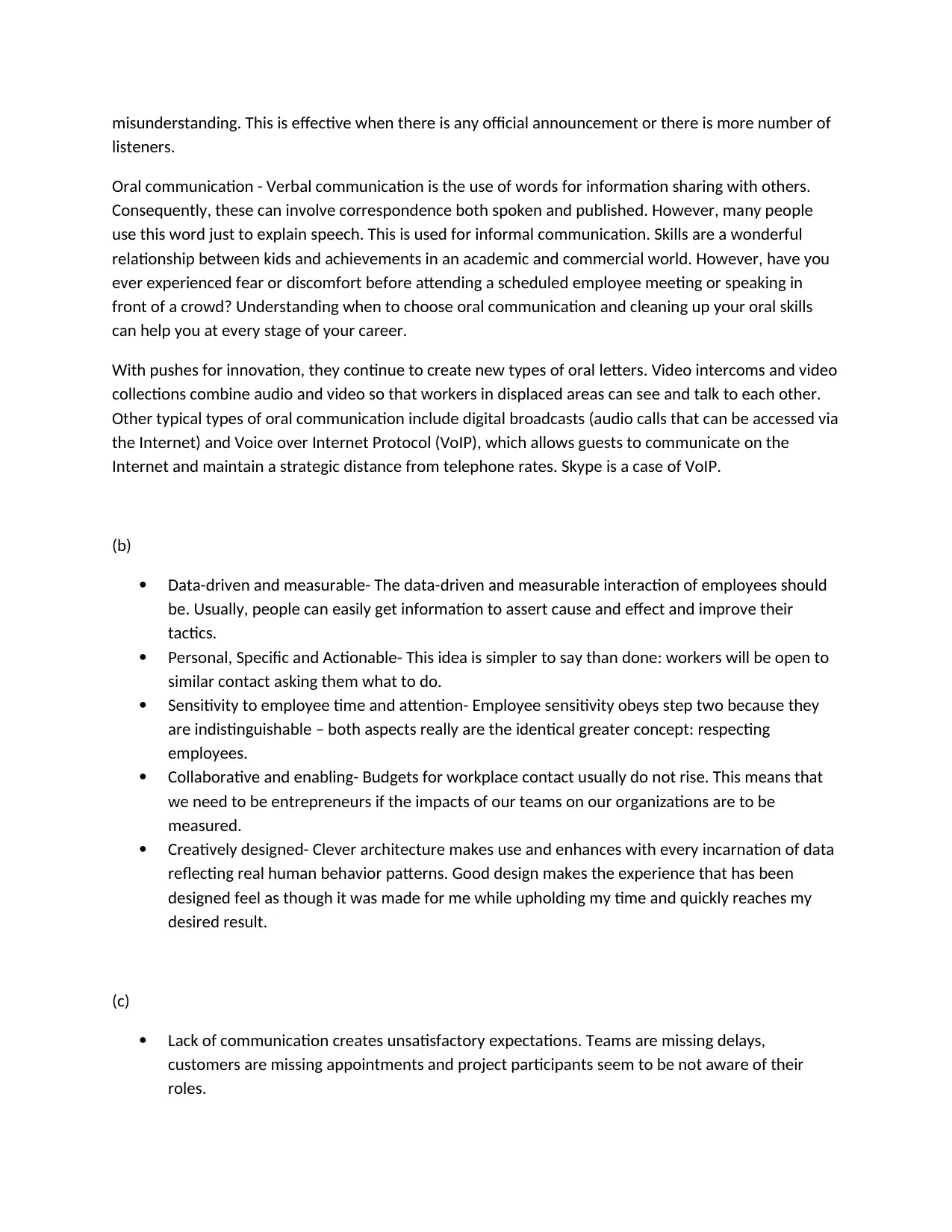
misunderstanding. This is effective when there is any official announcement or there is more number of
listeners.
Oral communication - Verbal communication is the use of words for information sharing with others.
Consequently, these can involve correspondence both spoken and published. However, many people
use this word just to explain speech. This is used for informal communication. Skills are a wonderful
relationship between kids and achievements in an academic and commercial world. However, have you
ever experienced fear or discomfort before attending a scheduled employee meeting or speaking in
front of a crowd? Understanding when to choose oral communication and cleaning up your oral skills
can help you at every stage of your career.
With pushes for innovation, they continue to create new types of oral letters. Video intercoms and video
collections combine audio and video so that workers in displaced areas can see and talk to each other.
Other typical types of oral communication include digital broadcasts (audio calls that can be accessed via
the Internet) and Voice over Internet Protocol (VoIP), which allows guests to communicate on the
Internet and maintain a strategic distance from telephone rates. Skype is a case of VoIP.
(b)
Data-driven and measurable- The data-driven and measurable interaction of employees should
be. Usually, people can easily get information to assert cause and effect and improve their
tactics.
Personal, Specific and Actionable- This idea is simpler to say than done: workers will be open to
similar contact asking them what to do.
Sensitivity to employee time and attention- Employee sensitivity obeys step two because they
are indistinguishable – both aspects really are the identical greater concept: respecting
employees.
Collaborative and enabling- Budgets for workplace contact usually do not rise. This means that
we need to be entrepreneurs if the impacts of our teams on our organizations are to be
measured.
Creatively designed- Clever architecture makes use and enhances with every incarnation of data
reflecting real human behavior patterns. Good design makes the experience that has been
designed feel as though it was made for me while upholding my time and quickly reaches my
desired result.
(c)
Lack of communication creates unsatisfactory expectations. Teams are missing delays,
customers are missing appointments and project participants seem to be not aware of their
roles.
listeners.
Oral communication - Verbal communication is the use of words for information sharing with others.
Consequently, these can involve correspondence both spoken and published. However, many people
use this word just to explain speech. This is used for informal communication. Skills are a wonderful
relationship between kids and achievements in an academic and commercial world. However, have you
ever experienced fear or discomfort before attending a scheduled employee meeting or speaking in
front of a crowd? Understanding when to choose oral communication and cleaning up your oral skills
can help you at every stage of your career.
With pushes for innovation, they continue to create new types of oral letters. Video intercoms and video
collections combine audio and video so that workers in displaced areas can see and talk to each other.
Other typical types of oral communication include digital broadcasts (audio calls that can be accessed via
the Internet) and Voice over Internet Protocol (VoIP), which allows guests to communicate on the
Internet and maintain a strategic distance from telephone rates. Skype is a case of VoIP.
(b)
Data-driven and measurable- The data-driven and measurable interaction of employees should
be. Usually, people can easily get information to assert cause and effect and improve their
tactics.
Personal, Specific and Actionable- This idea is simpler to say than done: workers will be open to
similar contact asking them what to do.
Sensitivity to employee time and attention- Employee sensitivity obeys step two because they
are indistinguishable – both aspects really are the identical greater concept: respecting
employees.
Collaborative and enabling- Budgets for workplace contact usually do not rise. This means that
we need to be entrepreneurs if the impacts of our teams on our organizations are to be
measured.
Creatively designed- Clever architecture makes use and enhances with every incarnation of data
reflecting real human behavior patterns. Good design makes the experience that has been
designed feel as though it was made for me while upholding my time and quickly reaches my
desired result.
(c)
Lack of communication creates unsatisfactory expectations. Teams are missing delays,
customers are missing appointments and project participants seem to be not aware of their
roles.
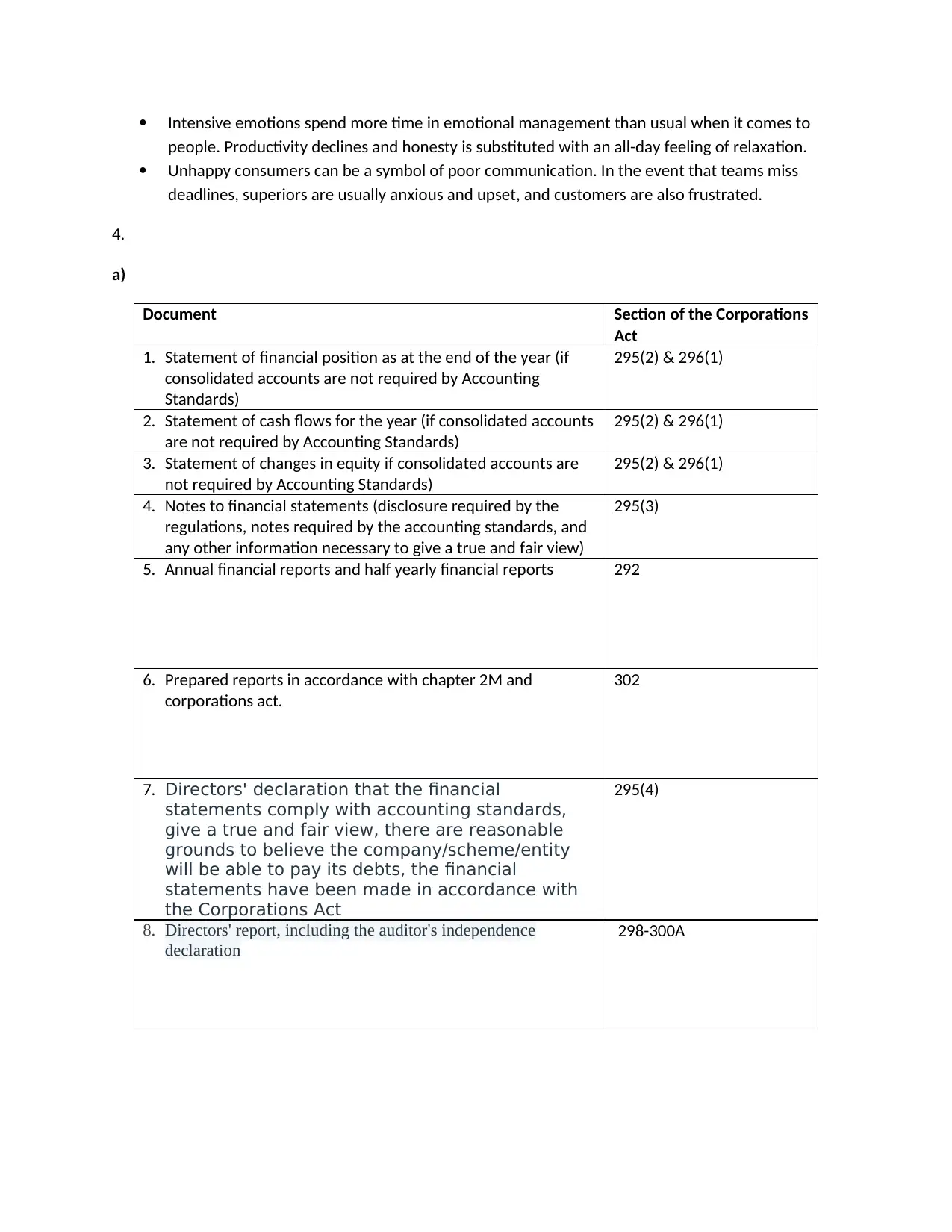
Intensive emotions spend more time in emotional management than usual when it comes to
people. Productivity declines and honesty is substituted with an all-day feeling of relaxation.
Unhappy consumers can be a symbol of poor communication. In the event that teams miss
deadlines, superiors are usually anxious and upset, and customers are also frustrated.
4.
a)
Document Section of the Corporations
Act
1. Statement of financial position as at the end of the year (if
consolidated accounts are not required by Accounting
Standards)
295(2) & 296(1)
2. Statement of cash flows for the year (if consolidated accounts
are not required by Accounting Standards)
295(2) & 296(1)
3. Statement of changes in equity if consolidated accounts are
not required by Accounting Standards)
295(2) & 296(1)
4. Notes to financial statements (disclosure required by the
regulations, notes required by the accounting standards, and
any other information necessary to give a true and fair view)
295(3)
5. Annual financial reports and half yearly financial reports 292
6. Prepared reports in accordance with chapter 2M and
corporations act.
302
7. Directors' declaration that the financial
statements comply with accounting standards,
give a true and fair view, there are reasonable
grounds to believe the company/scheme/entity
will be able to pay its debts, the financial
statements have been made in accordance with
the Corporations Act
295(4)
8. Directors' report, including the auditor's independence
declaration
298-300A
people. Productivity declines and honesty is substituted with an all-day feeling of relaxation.
Unhappy consumers can be a symbol of poor communication. In the event that teams miss
deadlines, superiors are usually anxious and upset, and customers are also frustrated.
4.
a)
Document Section of the Corporations
Act
1. Statement of financial position as at the end of the year (if
consolidated accounts are not required by Accounting
Standards)
295(2) & 296(1)
2. Statement of cash flows for the year (if consolidated accounts
are not required by Accounting Standards)
295(2) & 296(1)
3. Statement of changes in equity if consolidated accounts are
not required by Accounting Standards)
295(2) & 296(1)
4. Notes to financial statements (disclosure required by the
regulations, notes required by the accounting standards, and
any other information necessary to give a true and fair view)
295(3)
5. Annual financial reports and half yearly financial reports 292
6. Prepared reports in accordance with chapter 2M and
corporations act.
302
7. Directors' declaration that the financial
statements comply with accounting standards,
give a true and fair view, there are reasonable
grounds to believe the company/scheme/entity
will be able to pay its debts, the financial
statements have been made in accordance with
the Corporations Act
295(4)
8. Directors' report, including the auditor's independence
declaration
298-300A
⊘ This is a preview!⊘
Do you want full access?
Subscribe today to unlock all pages.

Trusted by 1+ million students worldwide
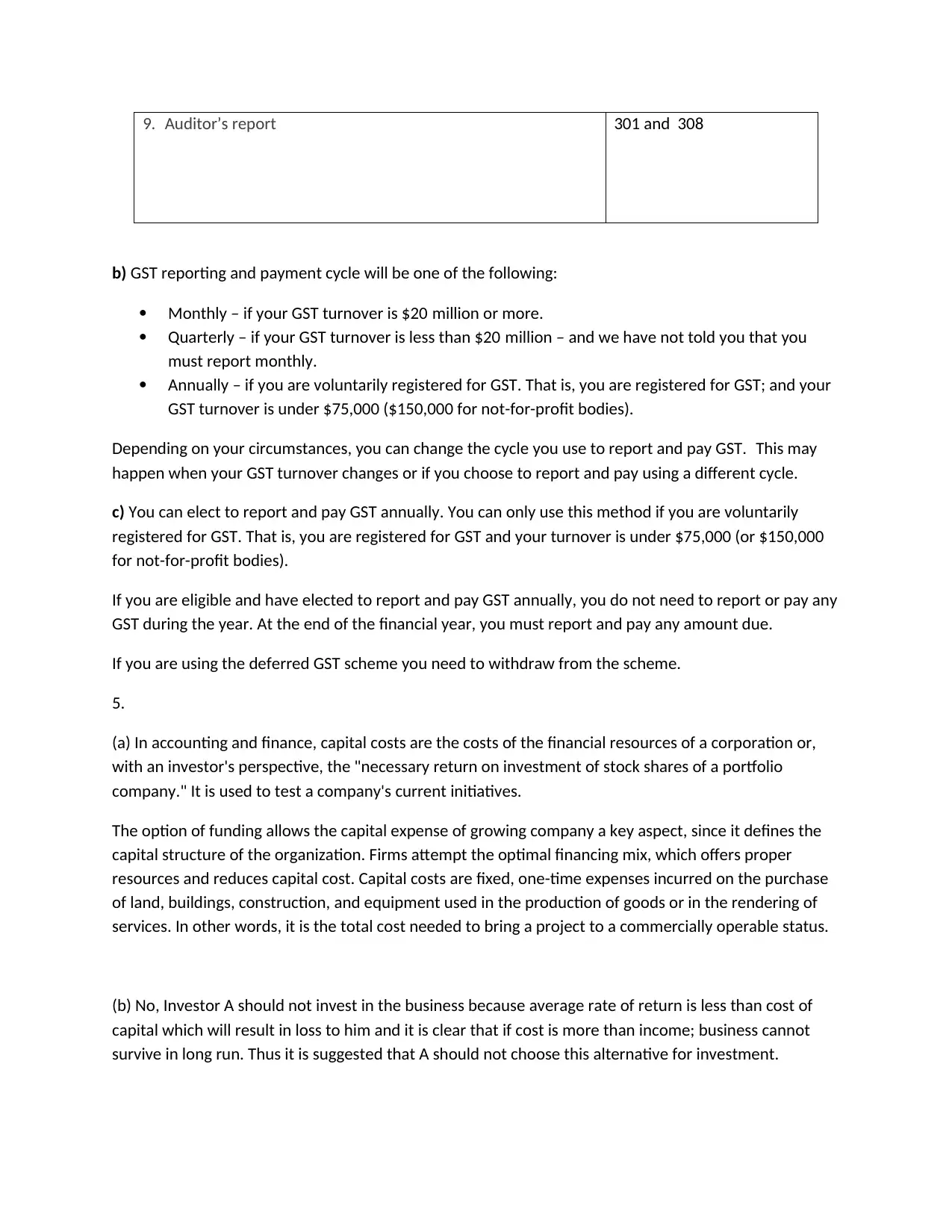
9. Auditor’s report 301 and 308
b) GST reporting and payment cycle will be one of the following:
Monthly – if your GST turnover is $20 million or more.
Quarterly – if your GST turnover is less than $20 million – and we have not told you that you
must report monthly.
Annually – if you are voluntarily registered for GST. That is, you are registered for GST; and your
GST turnover is under $75,000 ($150,000 for not-for-profit bodies).
Depending on your circumstances, you can change the cycle you use to report and pay GST. This may
happen when your GST turnover changes or if you choose to report and pay using a different cycle.
c) You can elect to report and pay GST annually. You can only use this method if you are voluntarily
registered for GST. That is, you are registered for GST and your turnover is under $75,000 (or $150,000
for not-for-profit bodies).
If you are eligible and have elected to report and pay GST annually, you do not need to report or pay any
GST during the year. At the end of the financial year, you must report and pay any amount due.
If you are using the deferred GST scheme you need to withdraw from the scheme.
5.
(a) In accounting and finance, capital costs are the costs of the financial resources of a corporation or,
with an investor's perspective, the "necessary return on investment of stock shares of a portfolio
company." It is used to test a company's current initiatives.
The option of funding allows the capital expense of growing company a key aspect, since it defines the
capital structure of the organization. Firms attempt the optimal financing mix, which offers proper
resources and reduces capital cost. Capital costs are fixed, one-time expenses incurred on the purchase
of land, buildings, construction, and equipment used in the production of goods or in the rendering of
services. In other words, it is the total cost needed to bring a project to a commercially operable status.
(b) No, Investor A should not invest in the business because average rate of return is less than cost of
capital which will result in loss to him and it is clear that if cost is more than income; business cannot
survive in long run. Thus it is suggested that A should not choose this alternative for investment.
b) GST reporting and payment cycle will be one of the following:
Monthly – if your GST turnover is $20 million or more.
Quarterly – if your GST turnover is less than $20 million – and we have not told you that you
must report monthly.
Annually – if you are voluntarily registered for GST. That is, you are registered for GST; and your
GST turnover is under $75,000 ($150,000 for not-for-profit bodies).
Depending on your circumstances, you can change the cycle you use to report and pay GST. This may
happen when your GST turnover changes or if you choose to report and pay using a different cycle.
c) You can elect to report and pay GST annually. You can only use this method if you are voluntarily
registered for GST. That is, you are registered for GST and your turnover is under $75,000 (or $150,000
for not-for-profit bodies).
If you are eligible and have elected to report and pay GST annually, you do not need to report or pay any
GST during the year. At the end of the financial year, you must report and pay any amount due.
If you are using the deferred GST scheme you need to withdraw from the scheme.
5.
(a) In accounting and finance, capital costs are the costs of the financial resources of a corporation or,
with an investor's perspective, the "necessary return on investment of stock shares of a portfolio
company." It is used to test a company's current initiatives.
The option of funding allows the capital expense of growing company a key aspect, since it defines the
capital structure of the organization. Firms attempt the optimal financing mix, which offers proper
resources and reduces capital cost. Capital costs are fixed, one-time expenses incurred on the purchase
of land, buildings, construction, and equipment used in the production of goods or in the rendering of
services. In other words, it is the total cost needed to bring a project to a commercially operable status.
(b) No, Investor A should not invest in the business because average rate of return is less than cost of
capital which will result in loss to him and it is clear that if cost is more than income; business cannot
survive in long run. Thus it is suggested that A should not choose this alternative for investment.
Paraphrase This Document
Need a fresh take? Get an instant paraphrase of this document with our AI Paraphraser
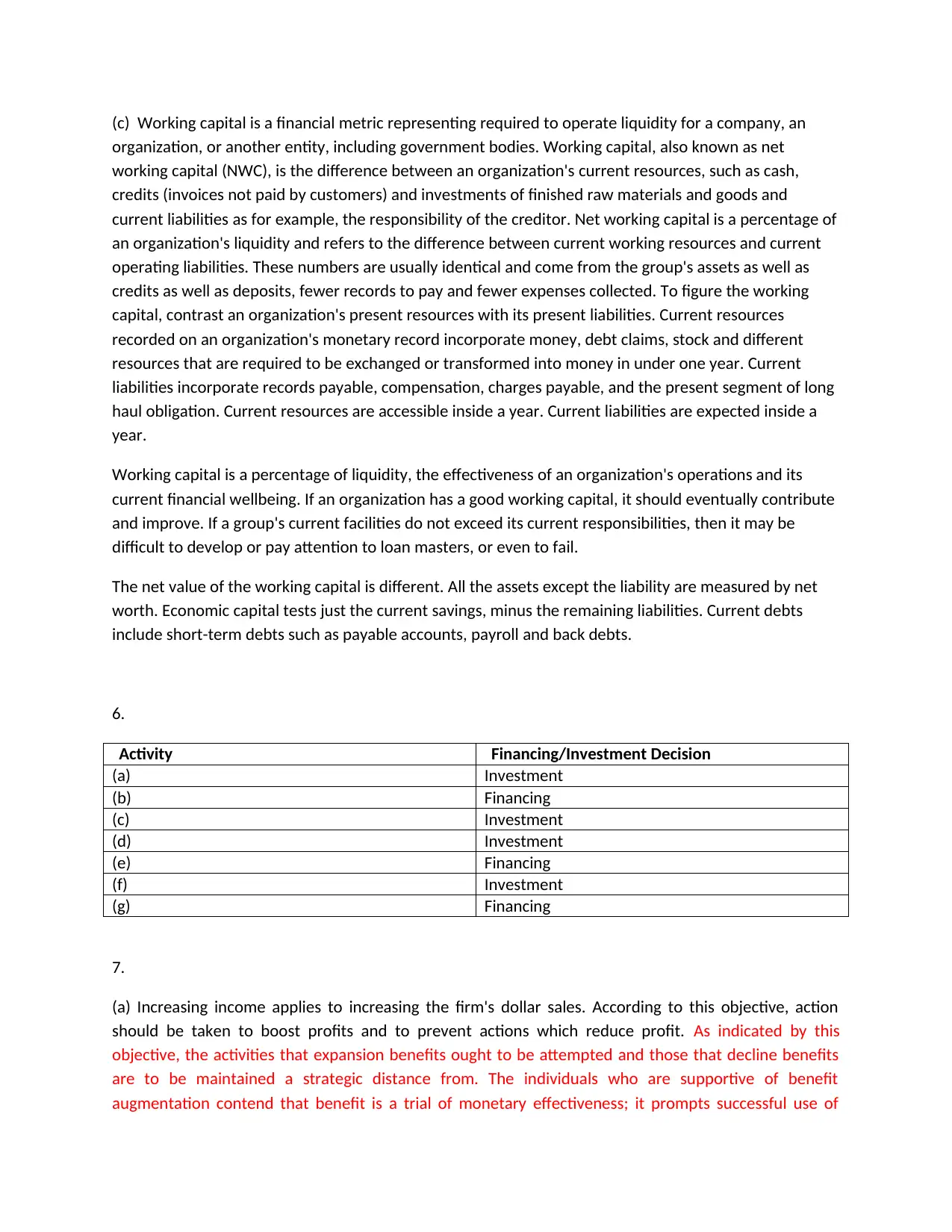
(c) Working capital is a financial metric representing required to operate liquidity for a company, an
organization, or another entity, including government bodies. Working capital, also known as net
working capital (NWC), is the difference between an organization's current resources, such as cash,
credits (invoices not paid by customers) and investments of finished raw materials and goods and
current liabilities as for example, the responsibility of the creditor. Net working capital is a percentage of
an organization's liquidity and refers to the difference between current working resources and current
operating liabilities. These numbers are usually identical and come from the group's assets as well as
credits as well as deposits, fewer records to pay and fewer expenses collected. To figure the working
capital, contrast an organization's present resources with its present liabilities. Current resources
recorded on an organization's monetary record incorporate money, debt claims, stock and different
resources that are required to be exchanged or transformed into money in under one year. Current
liabilities incorporate records payable, compensation, charges payable, and the present segment of long
haul obligation. Current resources are accessible inside a year. Current liabilities are expected inside a
year.
Working capital is a percentage of liquidity, the effectiveness of an organization's operations and its
current financial wellbeing. If an organization has a good working capital, it should eventually contribute
and improve. If a group's current facilities do not exceed its current responsibilities, then it may be
difficult to develop or pay attention to loan masters, or even to fail.
The net value of the working capital is different. All the assets except the liability are measured by net
worth. Economic capital tests just the current savings, minus the remaining liabilities. Current debts
include short-term debts such as payable accounts, payroll and back debts.
6.
Activity Financing/Investment Decision
(a) Investment
(b) Financing
(c) Investment
(d) Investment
(e) Financing
(f) Investment
(g) Financing
7.
(a) Increasing income applies to increasing the firm's dollar sales. According to this objective, action
should be taken to boost profits and to prevent actions which reduce profit. As indicated by this
objective, the activities that expansion benefits ought to be attempted and those that decline benefits
are to be maintained a strategic distance from. The individuals who are supportive of benefit
augmentation contend that benefit is a trial of monetary effectiveness; it prompts successful use of
organization, or another entity, including government bodies. Working capital, also known as net
working capital (NWC), is the difference between an organization's current resources, such as cash,
credits (invoices not paid by customers) and investments of finished raw materials and goods and
current liabilities as for example, the responsibility of the creditor. Net working capital is a percentage of
an organization's liquidity and refers to the difference between current working resources and current
operating liabilities. These numbers are usually identical and come from the group's assets as well as
credits as well as deposits, fewer records to pay and fewer expenses collected. To figure the working
capital, contrast an organization's present resources with its present liabilities. Current resources
recorded on an organization's monetary record incorporate money, debt claims, stock and different
resources that are required to be exchanged or transformed into money in under one year. Current
liabilities incorporate records payable, compensation, charges payable, and the present segment of long
haul obligation. Current resources are accessible inside a year. Current liabilities are expected inside a
year.
Working capital is a percentage of liquidity, the effectiveness of an organization's operations and its
current financial wellbeing. If an organization has a good working capital, it should eventually contribute
and improve. If a group's current facilities do not exceed its current responsibilities, then it may be
difficult to develop or pay attention to loan masters, or even to fail.
The net value of the working capital is different. All the assets except the liability are measured by net
worth. Economic capital tests just the current savings, minus the remaining liabilities. Current debts
include short-term debts such as payable accounts, payroll and back debts.
6.
Activity Financing/Investment Decision
(a) Investment
(b) Financing
(c) Investment
(d) Investment
(e) Financing
(f) Investment
(g) Financing
7.
(a) Increasing income applies to increasing the firm's dollar sales. According to this objective, action
should be taken to boost profits and to prevent actions which reduce profit. As indicated by this
objective, the activities that expansion benefits ought to be attempted and those that decline benefits
are to be maintained a strategic distance from. The individuals who are supportive of benefit
augmentation contend that benefit is a trial of monetary effectiveness; it prompts successful use of
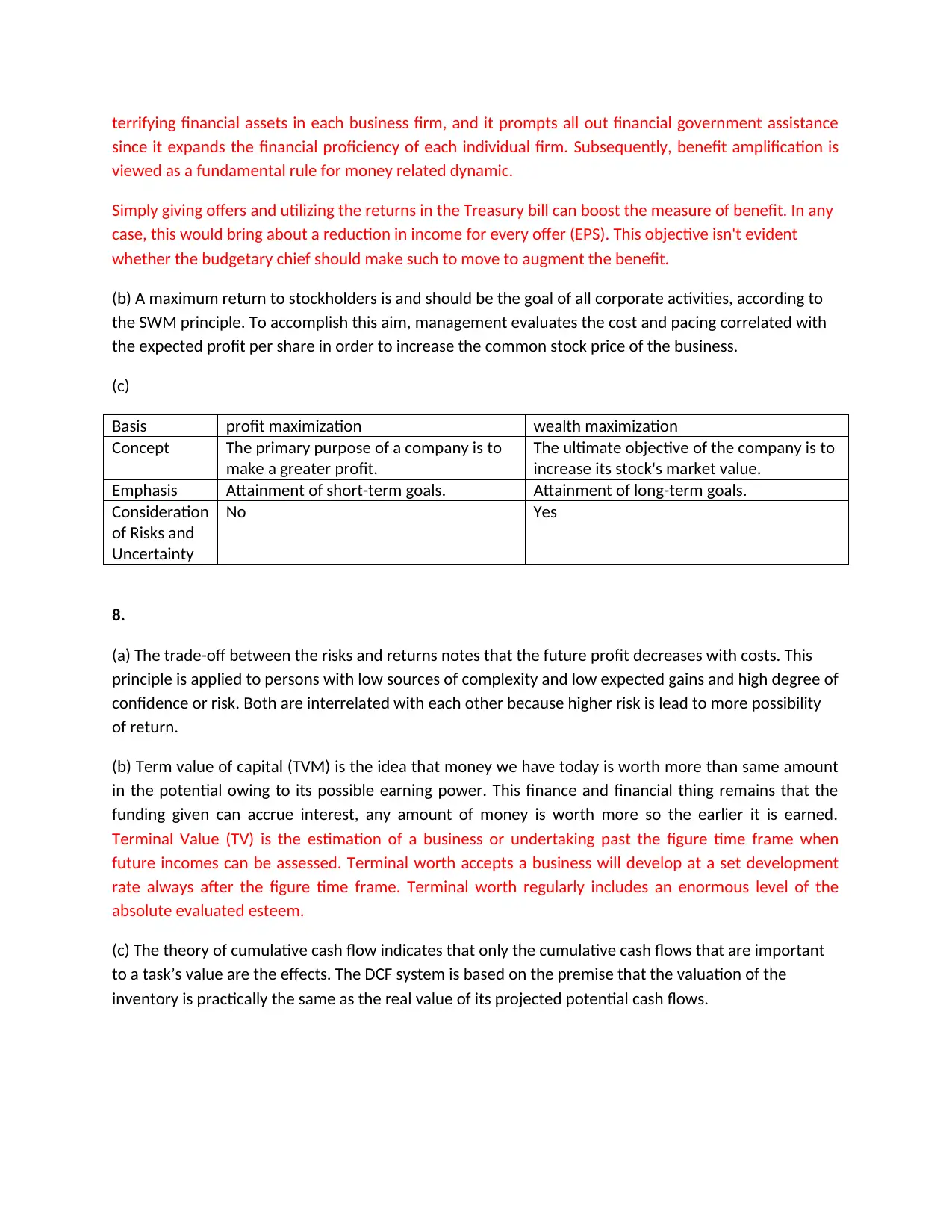
terrifying financial assets in each business firm, and it prompts all out financial government assistance
since it expands the financial proficiency of each individual firm. Subsequently, benefit amplification is
viewed as a fundamental rule for money related dynamic.
Simply giving offers and utilizing the returns in the Treasury bill can boost the measure of benefit. In any
case, this would bring about a reduction in income for every offer (EPS). This objective isn't evident
whether the budgetary chief should make such to move to augment the benefit.
(b) A maximum return to stockholders is and should be the goal of all corporate activities, according to
the SWM principle. To accomplish this aim, management evaluates the cost and pacing correlated with
the expected profit per share in order to increase the common stock price of the business.
(c)
Basis profit maximization wealth maximization
Concept The primary purpose of a company is to
make a greater profit.
The ultimate objective of the company is to
increase its stock's market value.
Emphasis Attainment of short-term goals. Attainment of long-term goals.
Consideration
of Risks and
Uncertainty
No Yes
8.
(a) The trade-off between the risks and returns notes that the future profit decreases with costs. This
principle is applied to persons with low sources of complexity and low expected gains and high degree of
confidence or risk. Both are interrelated with each other because higher risk is lead to more possibility
of return.
(b) Term value of capital (TVM) is the idea that money we have today is worth more than same amount
in the potential owing to its possible earning power. This finance and financial thing remains that the
funding given can accrue interest, any amount of money is worth more so the earlier it is earned.
Terminal Value (TV) is the estimation of a business or undertaking past the figure time frame when
future incomes can be assessed. Terminal worth accepts a business will develop at a set development
rate always after the figure time frame. Terminal worth regularly includes an enormous level of the
absolute evaluated esteem.
(c) The theory of cumulative cash flow indicates that only the cumulative cash flows that are important
to a task’s value are the effects. The DCF system is based on the premise that the valuation of the
inventory is practically the same as the real value of its projected potential cash flows.
since it expands the financial proficiency of each individual firm. Subsequently, benefit amplification is
viewed as a fundamental rule for money related dynamic.
Simply giving offers and utilizing the returns in the Treasury bill can boost the measure of benefit. In any
case, this would bring about a reduction in income for every offer (EPS). This objective isn't evident
whether the budgetary chief should make such to move to augment the benefit.
(b) A maximum return to stockholders is and should be the goal of all corporate activities, according to
the SWM principle. To accomplish this aim, management evaluates the cost and pacing correlated with
the expected profit per share in order to increase the common stock price of the business.
(c)
Basis profit maximization wealth maximization
Concept The primary purpose of a company is to
make a greater profit.
The ultimate objective of the company is to
increase its stock's market value.
Emphasis Attainment of short-term goals. Attainment of long-term goals.
Consideration
of Risks and
Uncertainty
No Yes
8.
(a) The trade-off between the risks and returns notes that the future profit decreases with costs. This
principle is applied to persons with low sources of complexity and low expected gains and high degree of
confidence or risk. Both are interrelated with each other because higher risk is lead to more possibility
of return.
(b) Term value of capital (TVM) is the idea that money we have today is worth more than same amount
in the potential owing to its possible earning power. This finance and financial thing remains that the
funding given can accrue interest, any amount of money is worth more so the earlier it is earned.
Terminal Value (TV) is the estimation of a business or undertaking past the figure time frame when
future incomes can be assessed. Terminal worth accepts a business will develop at a set development
rate always after the figure time frame. Terminal worth regularly includes an enormous level of the
absolute evaluated esteem.
(c) The theory of cumulative cash flow indicates that only the cumulative cash flows that are important
to a task’s value are the effects. The DCF system is based on the premise that the valuation of the
inventory is practically the same as the real value of its projected potential cash flows.
⊘ This is a preview!⊘
Do you want full access?
Subscribe today to unlock all pages.

Trusted by 1+ million students worldwide
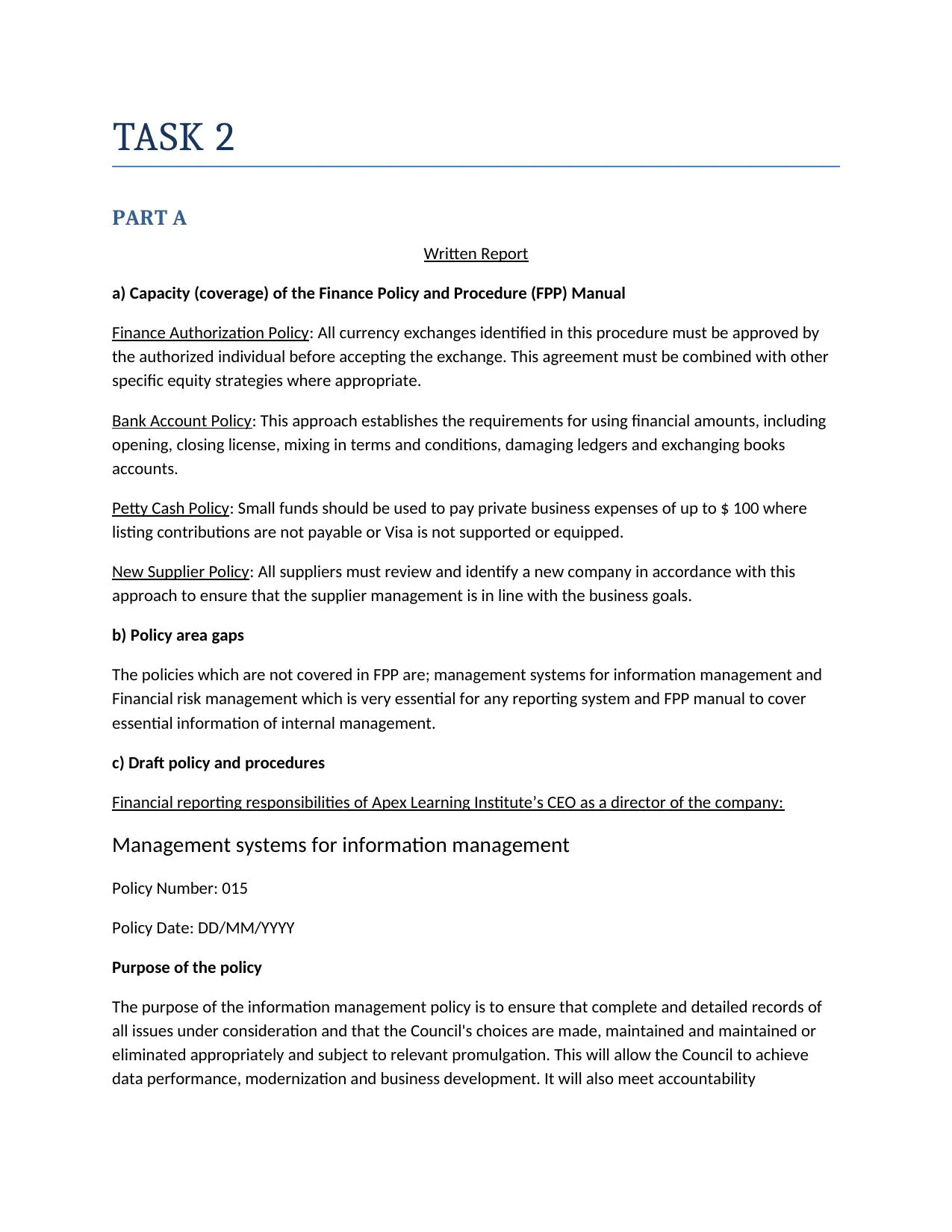
TASK 2
PART A
Written Report
a) Capacity (coverage) of the Finance Policy and Procedure (FPP) Manual
Finance Authorization Policy: All currency exchanges identified in this procedure must be approved by
the authorized individual before accepting the exchange. This agreement must be combined with other
specific equity strategies where appropriate.
Bank Account Policy: This approach establishes the requirements for using financial amounts, including
opening, closing license, mixing in terms and conditions, damaging ledgers and exchanging books
accounts.
Petty Cash Policy: Small funds should be used to pay private business expenses of up to $ 100 where
listing contributions are not payable or Visa is not supported or equipped.
New Supplier Policy: All suppliers must review and identify a new company in accordance with this
approach to ensure that the supplier management is in line with the business goals.
b) Policy area gaps
The policies which are not covered in FPP are; management systems for information management and
Financial risk management which is very essential for any reporting system and FPP manual to cover
essential information of internal management.
c) Draft policy and procedures
Financial reporting responsibilities of Apex Learning Institute’s CEO as a director of the company:
Management systems for information management
Policy Number: 015
Policy Date: DD/MM/YYYY
Purpose of the policy
The purpose of the information management policy is to ensure that complete and detailed records of
all issues under consideration and that the Council's choices are made, maintained and maintained or
eliminated appropriately and subject to relevant promulgation. This will allow the Council to achieve
data performance, modernization and business development. It will also meet accountability
PART A
Written Report
a) Capacity (coverage) of the Finance Policy and Procedure (FPP) Manual
Finance Authorization Policy: All currency exchanges identified in this procedure must be approved by
the authorized individual before accepting the exchange. This agreement must be combined with other
specific equity strategies where appropriate.
Bank Account Policy: This approach establishes the requirements for using financial amounts, including
opening, closing license, mixing in terms and conditions, damaging ledgers and exchanging books
accounts.
Petty Cash Policy: Small funds should be used to pay private business expenses of up to $ 100 where
listing contributions are not payable or Visa is not supported or equipped.
New Supplier Policy: All suppliers must review and identify a new company in accordance with this
approach to ensure that the supplier management is in line with the business goals.
b) Policy area gaps
The policies which are not covered in FPP are; management systems for information management and
Financial risk management which is very essential for any reporting system and FPP manual to cover
essential information of internal management.
c) Draft policy and procedures
Financial reporting responsibilities of Apex Learning Institute’s CEO as a director of the company:
Management systems for information management
Policy Number: 015
Policy Date: DD/MM/YYYY
Purpose of the policy
The purpose of the information management policy is to ensure that complete and detailed records of
all issues under consideration and that the Council's choices are made, maintained and maintained or
eliminated appropriately and subject to relevant promulgation. This will allow the Council to achieve
data performance, modernization and business development. It will also meet accountability
Paraphrase This Document
Need a fresh take? Get an instant paraphrase of this document with our AI Paraphraser
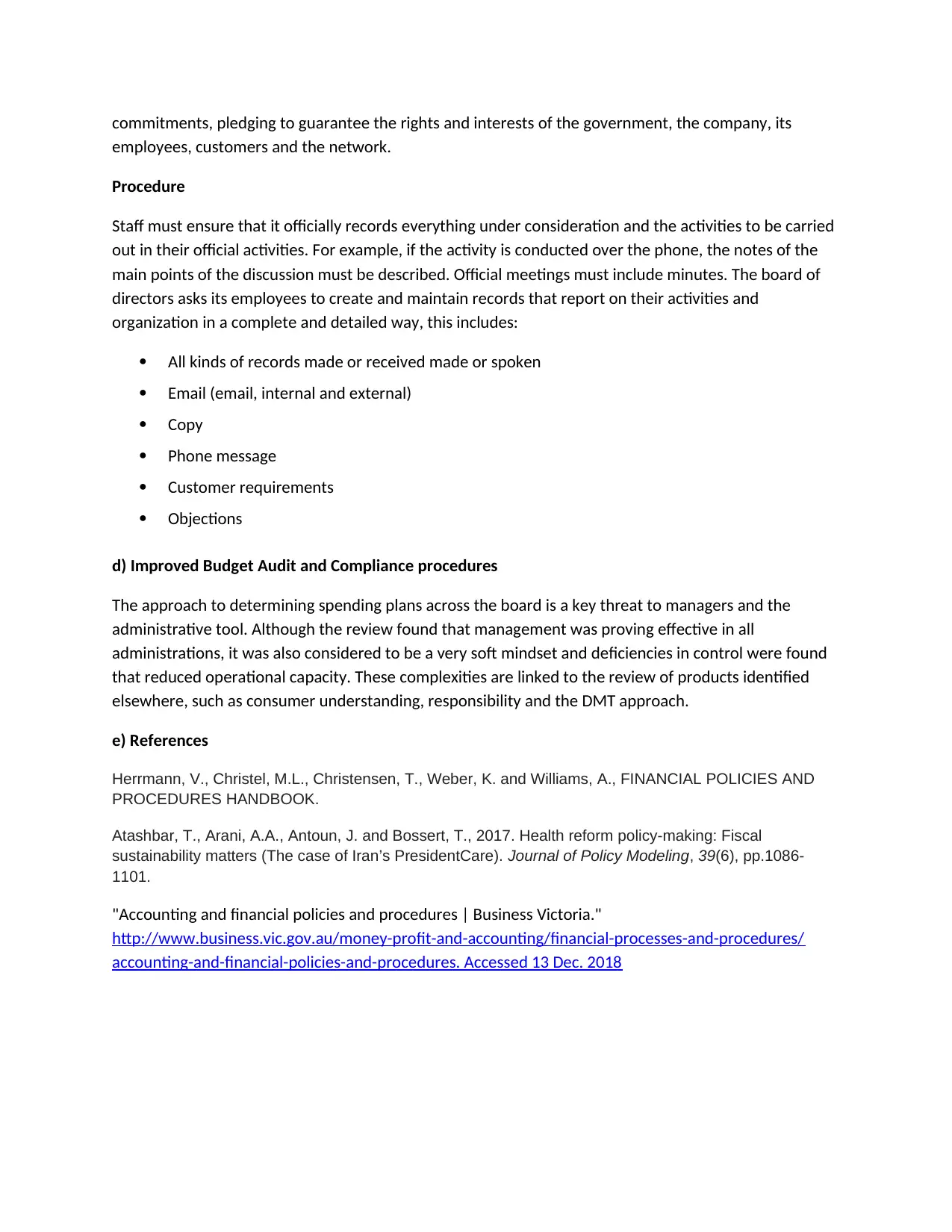
commitments, pledging to guarantee the rights and interests of the government, the company, its
employees, customers and the network.
Procedure
Staff must ensure that it officially records everything under consideration and the activities to be carried
out in their official activities. For example, if the activity is conducted over the phone, the notes of the
main points of the discussion must be described. Official meetings must include minutes. The board of
directors asks its employees to create and maintain records that report on their activities and
organization in a complete and detailed way, this includes:
All kinds of records made or received made or spoken
Email (email, internal and external)
Copy
Phone message
Customer requirements
Objections
d) Improved Budget Audit and Compliance procedures
The approach to determining spending plans across the board is a key threat to managers and the
administrative tool. Although the review found that management was proving effective in all
administrations, it was also considered to be a very soft mindset and deficiencies in control were found
that reduced operational capacity. These complexities are linked to the review of products identified
elsewhere, such as consumer understanding, responsibility and the DMT approach.
e) References
Herrmann, V., Christel, M.L., Christensen, T., Weber, K. and Williams, A., FINANCIAL POLICIES AND
PROCEDURES HANDBOOK.
Atashbar, T., Arani, A.A., Antoun, J. and Bossert, T., 2017. Health reform policy-making: Fiscal
sustainability matters (The case of Iran’s PresidentCare). Journal of Policy Modeling, 39(6), pp.1086-
1101.
"Accounting and financial policies and procedures | Business Victoria."
http://www.business.vic.gov.au/money-profit-and-accounting/financial-processes-and-procedures/
accounting-and-financial-policies-and-procedures. Accessed 13 Dec. 2018
employees, customers and the network.
Procedure
Staff must ensure that it officially records everything under consideration and the activities to be carried
out in their official activities. For example, if the activity is conducted over the phone, the notes of the
main points of the discussion must be described. Official meetings must include minutes. The board of
directors asks its employees to create and maintain records that report on their activities and
organization in a complete and detailed way, this includes:
All kinds of records made or received made or spoken
Email (email, internal and external)
Copy
Phone message
Customer requirements
Objections
d) Improved Budget Audit and Compliance procedures
The approach to determining spending plans across the board is a key threat to managers and the
administrative tool. Although the review found that management was proving effective in all
administrations, it was also considered to be a very soft mindset and deficiencies in control were found
that reduced operational capacity. These complexities are linked to the review of products identified
elsewhere, such as consumer understanding, responsibility and the DMT approach.
e) References
Herrmann, V., Christel, M.L., Christensen, T., Weber, K. and Williams, A., FINANCIAL POLICIES AND
PROCEDURES HANDBOOK.
Atashbar, T., Arani, A.A., Antoun, J. and Bossert, T., 2017. Health reform policy-making: Fiscal
sustainability matters (The case of Iran’s PresidentCare). Journal of Policy Modeling, 39(6), pp.1086-
1101.
"Accounting and financial policies and procedures | Business Victoria."
http://www.business.vic.gov.au/money-profit-and-accounting/financial-processes-and-procedures/
accounting-and-financial-policies-and-procedures. Accessed 13 Dec. 2018
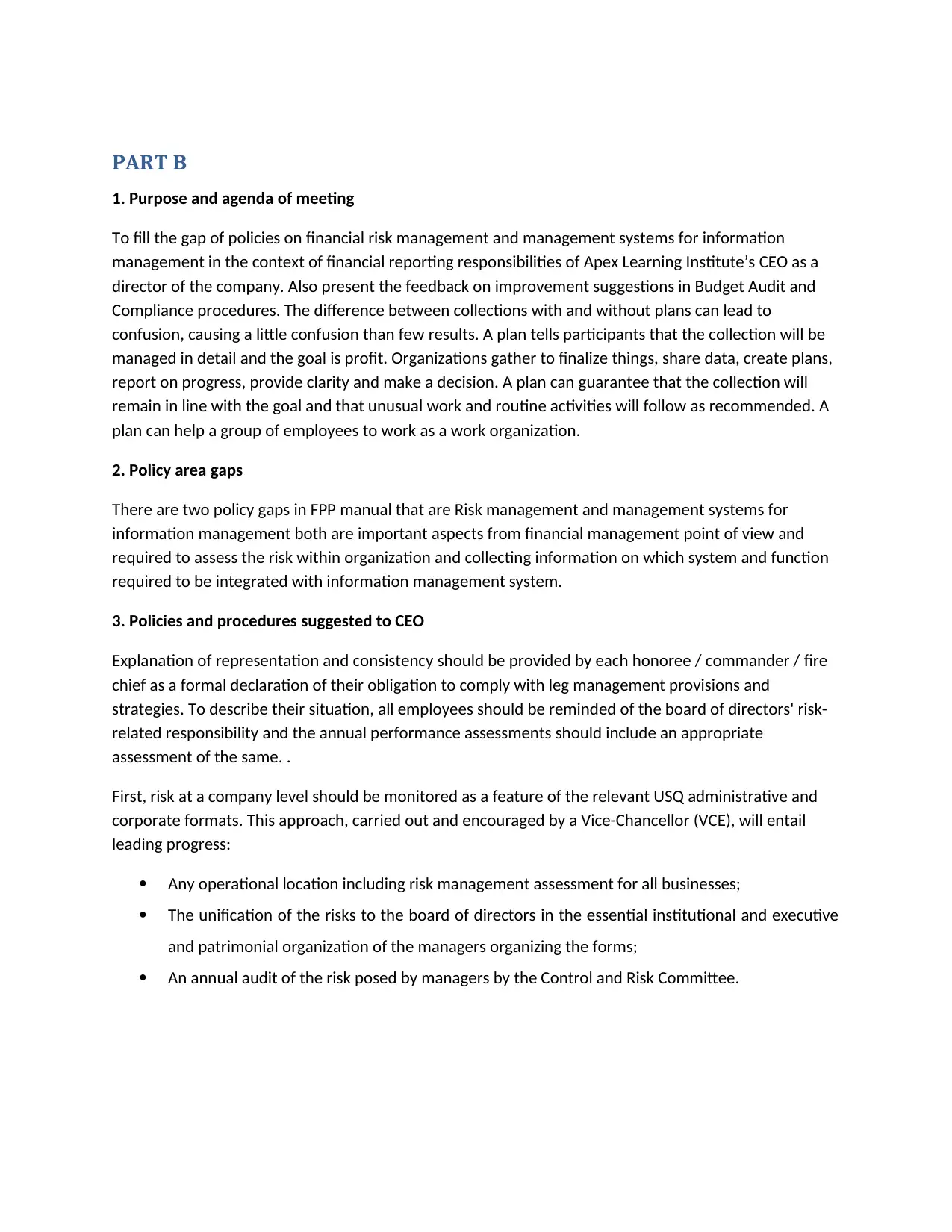
PART B
1. Purpose and agenda of meeting
To fill the gap of policies on financial risk management and management systems for information
management in the context of financial reporting responsibilities of Apex Learning Institute’s CEO as a
director of the company. Also present the feedback on improvement suggestions in Budget Audit and
Compliance procedures. The difference between collections with and without plans can lead to
confusion, causing a little confusion than few results. A plan tells participants that the collection will be
managed in detail and the goal is profit. Organizations gather to finalize things, share data, create plans,
report on progress, provide clarity and make a decision. A plan can guarantee that the collection will
remain in line with the goal and that unusual work and routine activities will follow as recommended. A
plan can help a group of employees to work as a work organization.
2. Policy area gaps
There are two policy gaps in FPP manual that are Risk management and management systems for
information management both are important aspects from financial management point of view and
required to assess the risk within organization and collecting information on which system and function
required to be integrated with information management system.
3. Policies and procedures suggested to CEO
Explanation of representation and consistency should be provided by each honoree / commander / fire
chief as a formal declaration of their obligation to comply with leg management provisions and
strategies. To describe their situation, all employees should be reminded of the board of directors' risk-
related responsibility and the annual performance assessments should include an appropriate
assessment of the same. .
First, risk at a company level should be monitored as a feature of the relevant USQ administrative and
corporate formats. This approach, carried out and encouraged by a Vice-Chancellor (VCE), will entail
leading progress:
Any operational location including risk management assessment for all businesses;
The unification of the risks to the board of directors in the essential institutional and executive
and patrimonial organization of the managers organizing the forms;
An annual audit of the risk posed by managers by the Control and Risk Committee.
1. Purpose and agenda of meeting
To fill the gap of policies on financial risk management and management systems for information
management in the context of financial reporting responsibilities of Apex Learning Institute’s CEO as a
director of the company. Also present the feedback on improvement suggestions in Budget Audit and
Compliance procedures. The difference between collections with and without plans can lead to
confusion, causing a little confusion than few results. A plan tells participants that the collection will be
managed in detail and the goal is profit. Organizations gather to finalize things, share data, create plans,
report on progress, provide clarity and make a decision. A plan can guarantee that the collection will
remain in line with the goal and that unusual work and routine activities will follow as recommended. A
plan can help a group of employees to work as a work organization.
2. Policy area gaps
There are two policy gaps in FPP manual that are Risk management and management systems for
information management both are important aspects from financial management point of view and
required to assess the risk within organization and collecting information on which system and function
required to be integrated with information management system.
3. Policies and procedures suggested to CEO
Explanation of representation and consistency should be provided by each honoree / commander / fire
chief as a formal declaration of their obligation to comply with leg management provisions and
strategies. To describe their situation, all employees should be reminded of the board of directors' risk-
related responsibility and the annual performance assessments should include an appropriate
assessment of the same. .
First, risk at a company level should be monitored as a feature of the relevant USQ administrative and
corporate formats. This approach, carried out and encouraged by a Vice-Chancellor (VCE), will entail
leading progress:
Any operational location including risk management assessment for all businesses;
The unification of the risks to the board of directors in the essential institutional and executive
and patrimonial organization of the managers organizing the forms;
An annual audit of the risk posed by managers by the Control and Risk Committee.
⊘ This is a preview!⊘
Do you want full access?
Subscribe today to unlock all pages.

Trusted by 1+ million students worldwide
1 out of 15
Related Documents
Your All-in-One AI-Powered Toolkit for Academic Success.
+13062052269
info@desklib.com
Available 24*7 on WhatsApp / Email
![[object Object]](/_next/static/media/star-bottom.7253800d.svg)
Unlock your academic potential
Copyright © 2020–2025 A2Z Services. All Rights Reserved. Developed and managed by ZUCOL.


